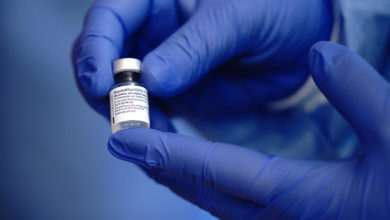Complementary Therapies for Cancer Care: What Research Says

fter Marianne Sarcich underwent treatment for breast cancer in 2016, she called an acupuncturist in hopes of easing her cancer-related anxiety—but made sure to be upfront.
“I told her right away that I didn’t think this would work, I didn’t believe in it, but I was desperate,” she says. “Absolutely nothing else was helping. I only considered acupuncture to knock it off the list of possibilities.”
It worked, to her surprise. Over a few months of sessions, she felt the tightness of anxiety began to loosen, and Sarcich began considering other complementary options she’d dismissed previously. Breathwork, reiki (a type of energy healing), mindfulness, sound baths and yoga were all options she was interested in. According to her, all three of them helped in some way with her side effects.
“As these efforts layered on top of each other, it was a huge relief,” she says. These complementary therapies weren’t treating her cancer—nor did she expect them to—but they helped relieve her anxiety and improve her mood during her arduous treatments. Sarcich was elected to the Society for Integrative Oncology’s patient advocacy committee. This group recommends holistic, evidence-based therapies that complement FDA-approved cancer treatments. For people suffering from cancer, she also founded a peer support group with 1,000 members for those who want complementary therapies.
“If something works to address common issues in cancer care like pain, anxiety, mobility problems, depression, and fatigue,” she says, “you grab onto it, and you help others do the same.”
Shift towards complementary therapies
In the United States, complementary and alternative medicine has grown in popularity over the past decade, particularly among those with cancer. People with cancer might use complementary therapies alongside standard medical care—or, in the case of alternative medicine, instead of it. There is little evidence to prove the effectiveness of alternative or complementary medicine in treating cancer. It can also be dangerous to replace standard medical care with these alternative therapies.
According to the National Cancer Institute, integrative medicine is a combination of conventional and alternative medicine that can help reduce some side effects from cancer treatment. A growing number of comprehensive cancer centers are offering integrative medicine, and in 2018, for the first time, the American Society of Clinical Oncology (ASCO) endorsed the Society for Integrative Oncology’s evidence-based guidelines recommending certain integrative therapies during and after breast cancer treatment.
Each complementary therapy—whether meditation, hypnosis, yoga, tai chi, acupuncture, cannabis, supplements, chiropractic, reflexology, nutritional therapy, aromatherapy, energy healing, massage, music therapy, dance, or one of the many others—has a different level of evidence behind it, according to NCI, and people with cancer should discuss them with their health care provider before starting any.
A study was published in JAMA OncologyAccording to data from 2012 and 2019, 33% of all cancer patients in America used CAM. The real number is likely much higher—probably around 80%, says Dr. Steve Vasilev, medical director of integrative gynecologic oncology at Providence Saint John’s Health Center and professor at Saint John’s Cancer Institute in California.
“When I started practicing 30 years ago, patients were asking about fad therapies like snake venom,” he says. “But now, there’s much more interest in evidence-based therapy like acupuncture or nutritional changes. Fortunately, we now have more data that these really can be helpful.”
There are upsides and disadvantages
The greatest benefit of complementary therapy, Dr. Lakshmi Rajdev of Lenox Hill Hospital in New York, states that it empowers patients. It can be difficult and distressing to receive cancer treatment. The psychological importance of choosing alternative options is that it can give people a sense of control.
“Data supports the use of these complementary therapies in reducing stress and improving coping skills, which both benefit treatment overall,” says Rajdev. “They may not change the way the disease progresses, but they do help patients deal with their illness, and that’s hugely important.”
They can also reduce side effects of treatment, particularly those that impact quality of life like pain, nausea and vomiting. With ASCO’s endorsement and based on existing evidence, the Society for Integrative Oncology recommends meditation, music therapy, and yoga for anxiety, depression, and stress reduction among people undergoing breast cancer treatment, along with massage for improving mood and acupuncture and acupressure for reducing nausea and vomiting after chemotherapy.
Recent advances in cancer treatment have also made complementary therapies more effective, says Dr. Jack Jacoub. He is an oncologist who serves as medical director at Orange Coast Medical Center’s MemorialCare Cancer Institute.
“Cancer therapy is dramatically different than it was even five or 10 years ago,” he says. “There are still side effects, but we’re moving away from chemo and into targeted therapies that come with less nausea and pain. That means complementary therapies don’t have to be as intense to work. With minor muscle tightness, for example, maybe just a few sessions of massage can be helpful.”
Vasilev points out that while some therapies like acupuncture can result in significant mental and bodily shifts within weeks to months, others, like acupuncture may require several more. A few months can be significant for someone with cancer, especially when they’re struggling through intense symptoms like nausea and anxiety.
There are many things to consider. bigger potential downside is interference with conventional treatments, which is why patients should always tell their health care providers if they are using any therapies outside of what they’re prescribed. The JAMA OncologyA study showed that 29% people diagnosed with cancer using CAM therapies did not disclose this to their doctors. This is dangerous. Rajdev states that most of the interference with cancer treatments is caused by supplements, herbs and vitamins. These may not be natural, but they have been shown to decrease the effectiveness of chemotherapy.
“Nearly every patient asks me about supplements because they want to boost their immune system, and they tend to get deluged with advice from friends and family members about what to take,” Rajdev says. “The best advice here is to wait until after treatment for those, and focus instead on complementary therapies that don’t have potential interactions with chemo or pain medications.”
According to her, the best non-medical option to supplement cancer treatment is exercise. Evidence is abundant that regular exercise may significantly reduce cancer treatment side effects. This means that yoga or just walking can be a good option to boost your immune system.
Alternative medicine: The risks
Rather than integrating complementary therapies into a conventional cancer treatment plan, which might include typical treatments like radiation, surgery, and chemotherapy, a patient pursuing “alternative medicine” would do these therapies instead of standard medical treatment.
Alternative medicine may be harmful because there is little evidence that it works. Jacoub says that in some instances, alternative therapies may be more harmful than medical treatments.
“It’s a natural reaction to search for other answers, especially if you’re suspicious of the health care system or you’ve had negative experiences,” he says. “Cost may be another issue, where you’re concerned about how much cancer care will entail, so you want to try an alternative therapy first. Unfortunately, there is simply no compelling evidence that any of these therapies work for standalone cancer care, and they may cause you to delay treatment.”
Apple cofounder Steve Jobs was first diagnosed in 2003 with pancreatic disease at the age of 48. At first, Jobs decided to avoid conventional treatment and use dietary modifications, herbal formulations and acupuncture. However, nine months later, he changed his mind and decided on surgery. He then received targeted immunotherapy treatment. He died seven years later, and experts say it’s impossible to know if that delay shortened his life or whether those alternative therapies had any benefits. However, Jobs’ biographer Walter Isaacson later noted that the tech icon came to regret his decision to delay surgery and subsequent treatment.
Alternative medicine is attractive despite the risks and the lack of scientific evidence. According to a 2018 survey conducted by the American Society of Clinical Oncology, about 40% of Americans believe cancer can be cured through alternative therapies alone—a statistic the American Cancer Society calls alarming, since research suggests people who use alternative therapies in place of standard cancer treatments have much higher mortality rates.
Getting started
The fear of being on the brink of cancer treatment is frightening. Sarcich suggests that complementary therapies can help you move forward because they offer a sense of control.
“There is a sense that you need to do Something, because if you feel powerless in the midst of all this, it can be terrible,” she says. As long as it’s safe, “Why not try everything? It’s likely you’ll find a few options that will stick, and that you’ll actually love, even when you didn’t think that would be the case.”
If your chosen therapies aren’t potentially interfering with cancer treatment, there are usually only upsides to choices like art therapy, yoga, reiki, or massage, adds Rajdev.
“The data on interventions like these is compelling, and I’m a believer in some of these since I’ve seen them help my patients,” she says. “The first step is to talk with your oncologist and make a plan together.”
Read More From Time





